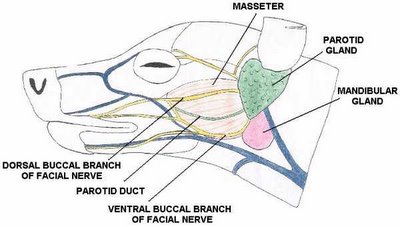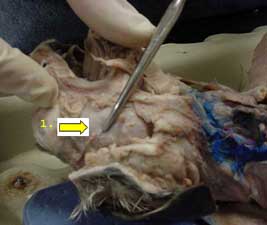Wednesday, February 22, 2006
کلیک کنید:

Parotid Salivary Gland Secretion
- Mixed serous and mucous (dog only)Innervation - Sympathetic - Cranial Cervical Sympathetic Ganglion (CCSG) Parasympathetic - Via parasympathetic fibres of the glossopharyngeal nerve from the otic ganglion The parotid gland is a triangular, lobular gland located at the ventral aspect of the ear. The parotid duct runs rostrally across the lateral surface of masseter between the dorsal and ventral buccal branches of the facial nerve and opens into the oral vestibule opposite the 4th upper pre-molar.

Mandibular Salivary Glands Secretion
- Mixed serous and mucous Innervation - Sympathetic - Cranial Cervical Sympathetic Ganglion(CCSG) Parasympathetic - Chorda Tympani of facial nerve The mandiular salivary gland is an ovoid, capsulated gland situated ventral to the parotid gland. Rostrally the capsule is fused to the monostomatic part of the sublingual gland. The mandibular duct runs rostrally, medial to digastricus and opens into the oral cavity at the sublingual caruncle on the floor of the oral cavity.
Sublingual Salivary Glands Secretion
- Mixed serous and mucous Innervation - Sympathetic - Cranial Cervical Sympathetic Ganglion (CCSG) Parasympathetic - Chorda Tympani of facial nerve The sublingual salivary gland has two parts (except in the horse). The compact monostomatic part has a fibrous capsule and is fused to the rostral border of the mandibular gland. Its duct opens into the oral vestibule near the sublingual caruncle. The diffuse polystomatic part spreads into tissues ventral to the floor of the oral cavity and drains via several ducts opening into the oral cavity on either side of the frenulum.
Dorsal and Ventral Buccal Salivary Glands Secretion
- Mixed serous and mucousInnervation - Sympathetic - Cranial Cervical Sympathetic Ganglion(CCSG) Parasympathetic - Otic Ganglion Relatively diffuse glands but in carnivores the dorsal buccal gland is consolidated into the zygomatic gland which is located ventral to the eye medial to the zygomatic arch. The glands drain into the oral cavity via numerous small ducts.
Monday, February 20, 2006
CAT HEAD & NECK MUSCLES







1. Masseter
Action: Elevates mandible
2. Temporalis
Action: Elevates mandible
3. Sternohyoideus
Action: Draws hyoid caudally
4. Cleidomastoideus
Action: Turns head and depresses snout or draws clavicle forward
5. Sternomastoideus (cranial )
Action: Turns head & depresses snout
6. Sternomastoideus (caudal)
Action: Turns head & depresses snout
7. Sternothyroideus
Action: Draws larynx caudally
8. Digastricus
Action: Depresses mandible
9. Mylohyoideus
Action: Raises floor of the mouth
Previous Posts
- پروانه ای که شهد گل نوش میکنیگل را ز یاد می بری و ...
- ردای پدر علم جهانیك نمونه دیگر از ارزشهای ایرانی ك...
- آپاشتا آمدنشریه علمی آپاشتاشماره چهارم بهار 86لطفا...
- baby animals!
- متابولیسم داروها(دكتر مرتضي ثمينيمتابولیسم مکانیسم...
- روز جهاني دامپزشكي بر همه ي شما دوستان عزيز مبارك...
- ....انقلاب درون . براي آزادي تو ز چنگ خواب و خستگي...
- نانو فناوري: علم بزرگ روزاز اهداف مهم فناوري نانو ...
- خرسند شدیم از اینکه امروز، رنگی دگر است ،نه رنگ دی...
- EMBRYOLOGYHead-Tail FoldingDue to the rapid growth...
پینوندها:
Department of Veterinary Anatomy
پینوندها:
بایگانی:
- 2005-11-20
- 2005-11-27
- 2005-12-04
- 2005-12-11
- 2005-12-18
- 2005-12-25
- 2006-01-01
- 2006-01-08
- 2006-01-15
- 2006-01-22
- 2006-01-29
- 2006-02-05
- 2006-02-12
- 2006-02-19
- 2006-02-26
- 2006-03-05
- 2006-03-12
- 2006-04-02
- 2006-04-09
- 2006-04-16
- 2006-04-30
- 2006-05-07
- 2006-05-14
- 2006-05-21
- 2006-05-28
- 2006-06-04
- 2006-06-11
- 2006-06-25
- 2006-07-16
- 2006-09-03
- 2006-09-24
- 2006-10-01
- 2006-11-05
- 2006-11-12
- 2006-11-19
- 2006-11-26
- 2007-02-25
- 2007-03-04
- 2007-04-22
- 2007-05-06
- 2007-05-13
- 2007-05-20
- 2007-08-12
